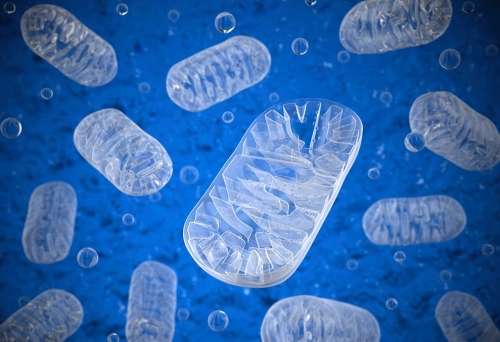Mitochondria are more than the cell's batteries, researchers say. Credit: University of Auckland
A ground-breaking Auckland study could lead to discoveries about many common diseases such as diabetes, cancer and dementia. The new finding could also illuminate the broader role of the enigmatic mitochondria in human development.
Mitochondria are specialised sub-units of cells often described as the cells' batteries or generators, as they supply most of the cell's energy. They're tiny – about 1000th of a millimetre across – with their own membranes. The more energy-hungry the cell type, the more mitochondria it contains – from several to thousands.
What's fascinating about them is they have their own DNA, separate from the cell's DNA in its nucleus. We receive the DNA in our cells' nuclei – organised into chromosomes - from both parents, but we inherit our mitochondrial DNA from our mothers only. Scientists think mitochondria were originally free-living bacteria.
Mutations in the mitochondrial DNA are relatively common - one in a few thousand people - and are linked to common illnesses as well as a wide range of fatal or progressively debilitating diseases including diabetes, gastrointestinal disorders, heart disease, dementia, deafness, and eye disorders.
Now, a team of Liggins Institute researchers have shown for the first time that human mitochondrial DNA leaves the mitochondria, travels into the host cell nucleus and connects to specific genes.
"We found evidence that mitochondria DNA and nuclear DNA 'talk to each other', and these interactions aren't random," says lead researcher Dr Justin O'Sullivan, a molecular geneticist at the University of Auckland research institute.
The findings give weight to the idea that mitochondria do much more than supply energy and regulate a cell's metabolism – the processes that keep it alive.
"We think the connections we detected are part of a feedback system between mitochondria and the cell nucleus that may influence how humans grow and develop throughout life," says Dr O'Sullivan.
"We know that these connections between mitochondrial and nuclear DNA can influence how the nuclear genes work in yeast, and we speculate that the same occurs in humans."
Interactions between the two sets of DNA within our cells could be one of the ways the environment influences gene expression, he says.
One theory about mitochondrial disease is that damaged mitochondria fail to supply enough energy to the cell so it can't work properly.
But this latest finding suggests another possible culprit: problems with the way the mitochondrial and nuclei DNA "talk" to each other – or fail to talk to each other.
"Mitochondrial dysfunction is linked to highly prevalent diseases such as obesity, diabetes, cancer and heart disease," says study co-author Associate Professor Mark Vickers, also from Liggins Institute.
"This study adds to our understanding of the way in which changes to mitochondria manifest as disease. Further research could yield new treatment avenues."
"Next, we need to figure out exactly how the two sets of DNA talk to each other, and the effects of that talking," says Dr O'Sullivan.
Liggins Institute PhD student Malina Doynova carried out the study.
The study report was published in Mitochondrion.
More information: M.D. Doynova et al. Interactions between mitochondrial and nuclear DNA in mammalian cells are non-random, Mitochondrion (2016). DOI: 10.1016/j.mito.2016.08.003
Provided by University of Auckland























